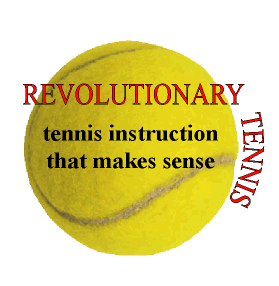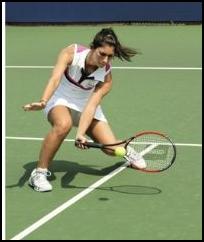Revolutionary Tennis |
||
Tennis Instruction That Makes Sense |
||
Head-On
VOLLEY Get More Punch on Low Volleys, by Ken Flach Photographs by M. David Leeds/Getty Images From the October 2004 issue of TENNIS Magazine
(Caption over photo: On a low volley, don't bring your racquet back above the ball.)
Let's say the ball is going to be at your ankles. You should prepare your racquet at that level with an open racquet face so you can get it in line with the flight of the ball. This way you'll be hitting the back of the ball (not the top of it) and moving your racquet from low to high on a diagonal line. Your follow-through should move upward as you lift the ball over the net on the same path and angle that it came in on. Instead of popping the ball up with too much underspin, now you're driving the ball over the tape and being aggressive with your low volleys. (Caption over photo 2: Instead, prepare it where you think the ball will be.) BREAK IT DOWN Low volley technique has meant getting down to the height of the ball with both racket face and hand, either keeping the racket head cocked above the wrist or maintaining a "V" of some sort between racket and wrist. As shown in Step 10, the establishment now opines, "The racket head can even be positioned below your wrist with the same wrist angle as when held above your wrist," which Revolutionary Tennis shows to be ridiculous. When Flach writes, "your first step should be to drop the racquet head to where you estimate the ball will be," that is good, but unfortunately the photos accompanying Flach's article still promote the silly idea of trying to keep the same wrist angle as when the ball is higher. The model gets her hand down low with the racket face, on the same plane even. As shown in Step 10 this technique reduces the strength available (in the hand and arm) for the shot, and the only way for you to be "driving the ball over the tape" is to take a whack at it instead of a punch. What is new here is the mention of hitting the low volley "from low to high." In fact, you don't drive a low volley because you can't, the upward angle required to clear the net is too steep for you to both hit the ball hard and prevent it from going long. You don't want to pop it up and yet you want to deny your opponent an easy pass attempt or lob. You will think "position" or "place" the ball instead of driving it, and get ready for your second, and hopefully last, shot. |
||
|
|
||||||||||||||||||||||||||||||||||||||||||||||||||||||||||||||

 Problem. You can't do anything with a low first volley You either pop it up, giving your opponent an easy look at a passing shot, or you put the ball in the net. Usually this happens because you don't have the proper racquet preparation and swing. You start with the racquet head above the incoming ball, with the racquet face perpendicular to the court, so you have to swing down and scoop the ball up. (The motion looks like a C.) A good indicator is to listen to your racquet—if you hear it clanking on the court on a low volley, then you know you don't have the right swing.
Problem. You can't do anything with a low first volley You either pop it up, giving your opponent an easy look at a passing shot, or you put the ball in the net. Usually this happens because you don't have the proper racquet preparation and swing. You start with the racquet head above the incoming ball, with the racquet face perpendicular to the court, so you have to swing down and scoop the ball up. (The motion looks like a C.) A good indicator is to listen to your racquet—if you hear it clanking on the court on a low volley, then you know you don't have the right swing. Solution. On volleys, we're taught to keep the racquet head above the wrist. But on the low volley, your first step should be to drop the racquet head to where you estimate the ball will be. With this immediate preparation, there should be time for a pause to stabilize the racquet before you start your volley swing.
Solution. On volleys, we're taught to keep the racquet head above the wrist. But on the low volley, your first step should be to drop the racquet head to where you estimate the ball will be. With this immediate preparation, there should be time for a pause to stabilize the racquet before you start your volley swing.